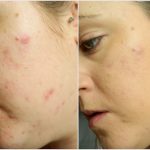ACNE ROSACEA
Introduction
Rosacea is a chronic skin condition involving inflammation of the cheeks, nose, chin, forehead, or eyelids. It may appear as redness, prominent spider-like blood vessels, swelling, or skin eruptions similar to acne. However, acne rosacea is not same as teenagers acne.
Causes
It is believed that Rosacea is a disorder where the blood vessels become damaged when repeatedly dilated by stimuli.
Triggers that cause Acne Rosacea
- Exposure to extreme temperature.
- Vigorous exercise.
- Emotional factors (anger, fear, anxiety, embarrassment etc.)
- Sun exposure.
- Severe sunburn.
- Cold air.
- Change of weather and temperature.
- Some foods and drinks that can trig the condition include alcohol, foods high in histamine-like yogurt, cheese, red wine etc. and spicy food.
- Certain medications (Vasodilator pills include blood pressure medications like nitrates, calcium channel blockers, and thiazide diuretics)
- Certain topical treatment for acne like microdermabrasion and chemical peels.

Symptoms of Acne Rosacea
- Redness of the face in localized areas or covering the entire face.
- A tendency to flush or blush easily.
- A burning or stinging sensation of the face.
- Increased number of spider-like blood vessels (telangiectasia) of the face.
- Rhinophyma (red, bulbous nose)
- Pimple-like skin eruptions.
- Watery eyes with redness.
Complications of Acne Rosacea
- Psychological stress.
- Lack of confidence.
- Social isolation.
- Permanent changes in appearance (for example, a bulbous nose)
Tips to avoid acute flare-ups
- Exposure to sun and to extreme temperatures should be limited as much as possible.
- Smoking, spicy foods, hot drinks, and alcohol may cause flushing and should be avoided.
- Red wine and chocolate are two well-known Rosacea triggers.
- Try to reduce stress. Try deep breathing, yoga, or other relaxation methods.
